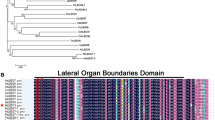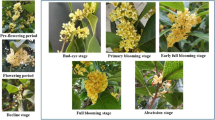Abstract
A small family of at least four genes encoding melon ascorbate oxidase (AO) has been identified and three members of it have been cloned. Preliminary DNA sequence determination suggested that melon AO genes code for enzymes homologous to ascorbate oxidases from other plants and similar to other multicopper oxidases. We describe detailed molecular studies addressing melon AO expression during organ specific differentiation, fruit development and ripening, and in response to wounding. In particular, AO transcript accumulation was induced in ovaries and the outer mesocarp of mature preclimacteric melon fruits, before the expression of genes encoding the necessary enzymatic activities for ethylene biosynthesis. On the other hand, AO was not expressed in late stages of fruit ripening and was repressed in wounded fruits. The role of ethylene in transcriptional regulation of AO is discussed.
Similar content being viewed by others
References
Abeles FB, Morgan PW, Saltveit KE Jr: Ethylene in Plant Biology. 2nd ed., Academic Press Inc, San Diego (1992).
Al Madhoon A, Sanmartin M, Diallinas G, Kanellis AK: Expression of ascorbic acid oxidase isoenzymes during development and ripening of melon fruit. International Workshop COST-95 ‘Consumer Perception and End-product Quality’, Feusisberg, Switzerland, December 14-16 (1995).
Albani D, Sardana R, Robert LS, Altosaar I, Arnison PG, Fabijanski SF: A Brassica napusgene family which shows sequence similarity to ascorbate oxidase is expressed in developing pollen. Molecular characterization and analysis of promoter activity in transgenic tobacco plants. Plant J 2: 331-342 (1992).
Arrigoni O: Ascorbate system in plant development. J Bionerget Biomembr 26: 407-419 (1994).
Avigliano L, Vecchini P, Sirianni P, Marcozzi G, Marchesini A, Mondovi B: A reinvestigation on the quaternary structure of ascorbate oxidase from Cucurbita pepo medullosa. Mol Cell Biochem 56: 107-112 (1983).
Balague C, Watson CF, Turner AJ, Rouge P, Picton S, Pech J-C, Grierson D: Isolation of a ripening and wound-induced cDNA from Cucumis meloL. encoding a protein with homology to the ethylene-forming enzyme. Eur J Biochem 212: 27-34 (1993).
Barry CS, Blume B, Bouzayen M, Cooper W, Hamilton AJ, Grierson D: Differential expression of the 1-aminocyclopropane-1-carboxylate oxidase gene family of tomato. Plant J 9: 525-535 (1996).
Bradford MM: A rapid and sensitive method for the quantification of microgram quantities of proteins utilising the principle of protein-dye binding. Anal Biochem 72: 248-254 (1976).
Carvalho Jr LB Lima CJ, Medeiros PH: Ascorbate oxidase from Cucurbita maximaPhytochem 20: 2423-2424 (1981).
Church GM, Gilbert W: Genomic sequencing. Proc Natl Acad Sci USA 81:1991-1995 (1984).
Clemetson CAB: Vitamin C. Vol I, pp. 318. CRC Press Boca Raton, Florida (1989).
Cole JL, Avigliano L, Morpurgo L, Solomon EI: Spectroscopic and chemical studies of the ascorbate oxidase trinuclear copper active site: comparison to laccase. J Am Chem Soc 113: 9080- 9089 (1991).
Deinum J, Reinhammar B, Marchesini A: The stoichiometry of the three different types of copper in ascorbate oxidase from green zucchini squash. FEBS Letters 42: 241-245 (1974).
Devereux J, Haeberli P, Smithies O: A comprehensive set of sequence analysis programs for the VAX. Nucl Acids Res 12: 387-395 (1984).
Diallinas G, Kanellis AK: A phenylalanine ammonia-lyase gene from melon fruit: cDNA cloning, sequence and expression in response to development and wounding. PlantMol Biol 26: 473-479 (1994).
Diallinas G, Pateraki I, Al Madhoon A, Sanmartin M, Panopoulos N, Kanellis AK: Expression and cloning of an ascorbate oxidase gene in melon. Proc Hellenic Bioch Biophys Soc, Newsletter 40, pp. 82-84 (1996).
Diallinas G, Pateraki I, Moser O, Tsigos J, Kanellis AK: Expression of ascorbate oxidase in response to development and wounding in melon fruit (Cucumis meloL.), 4th International Congress of Plant Molecular Biology, Amsterdam, Netherlands, June 19-24 (1994).
Dixon RA, Lamb CJ: Plant-microbial pathogen interactions. Annu Rev Plant Physiol Plant Mol Biol 41: 369-419 (1990)
Ecker JR, Davis RW: Plant defense genes are regulated by ethylene. Proc Natl Acad Sci USA 84: 5202-5206 (1987).
Esaka M, Fujisawa K, Goto M, Kisu Y: Regulation of ascorbate oxidase expression in pumpkin by auxin and copper. Plant Physiol 100: 231-237 (1992).
Esaka M, Hattori T, Fujisawa K, Sakajo S, Asahi T: Molecular cloning and nucleotide sequence of full-length cDNA for ascorbate oxidase from cultured pumpkin cells. Eur J Biochem 191: 537-541 (1990).
Esaka M, Fukui H, Suzuki K, Kubota K: Secretion of ascorbate oxidase by suspension-cultured pumpkin cells. Phytochem 28: 117-119 (1989).
Felton GW, Summers, CB: Potential role of ascorbate oxidase as a plant defence protein against insect herbivory. J Chem Ecol 19: 1553-1568 (1993).
Foyer CH, Descourvieres P, Kunert KJ: Protection against oxygen radicals: an improved defence mechanism study in transgenic plants. Plant Cell Environm 17: 507-523 (1994).
German UA, Lerch K: Isolation and partial sequence of the laccase gene from Neurospora crassa: Amino acid sequence homology of the protein to human ceruloplasmin. Proc Natl Acad Sci USA 83: 8854-8858 (1986).
Halliwell B, Gutteridge JMC: Free Radicals in Biology and Medicine, 2nd ed., Oxford University Press (1989).
Kato N, Esaka M: cDNA cloning and gene expression of ascorbate oxidase in tobacco. Plant Mol Biol 30: 833–837 (1996).
Kerk NM, Feldman LJ: A biochemical model for the initiation and maintenance of the quiescent center: implications for organization of root meristems. Development 121: 2825- 2833 (1995).
Lauton MA, Lamb CJ: Transcriptional activation of plant defense genes by fungal elicitor, wounding and infection. Mol Cell Biol 7: 335-341 (1987).
Lee MH, Dawson CR: Ascorbate oxidase. Further studies on the purification of the enzyme. J Biol Chem 248: 6596-6602 (1973).
Lee MH, Dawson CR: Ascorbate oxidase. Spectral characteristics of the enzyme. J Biol Chem 248: 6603-6609 (1973).
Lin LS, Varner JE: Expression of ascorbic acid oxidase in zucchini squash (Cucurbita pepoL.). Plant Physiol 96: 159- 165 (1991).
Lincoln JE, Campbell AD, Oetiker J, Rottmann WH, Oeller PW, Shen NF, Theologis A: LE-ACS4, a fruit ripening and wound-induced 1-aminocyclopropane-1-carboxylate synthase gene of tomato (Lycopersicon esculentum). J Biol Chem 268: 19422-19430 (1993).
Loewus FA: L-Ascorbic acid: metabolism, biosynthesis, function. In: Stumpf PK, Conn EE (eds), Biochemistry of Plants, Preiss J (ed.), Carbohydrates, Structure and Function, Vol 3, pp. 77–79. Academic Press, New York (1980).
Loulakakis KA, Roubelakis-Angelakis KA, Kanellis AK: Isolation of functional RNA from grapevine tissues poor in nucleic acid content. Am J Enol Vitic 47: 181-185 (1996).
Malmstrom BG, Andreasson LE, Reinhammar B: Coppercontaining oxidases and superoxide dismutase. In Boyer PD (ed.), The Enzymes, Vol 12, pp. 507-579. Academic Press, New York (1975).
Messerschmidt A, Huber R: The blue oxidases, ascorbate oxidase, laccase, and ceruloplasmin: modelling and structural relationships. Eur J Biochem 187: 341-352 (1990).
Messerschmidt A, Rossi A, Ladenstein R, Huber R, Bolognesi M, Gatti G, Marchesini R, Petruzzelli R, Finazzi-Agro A: X-ray crystal structure of the blue oxidase, ascorbate oxidase from zucchini: a preliminary analysis of the polypeptide fold and a model of the copper sites and ligands. J Mol Biol 206: 515-527 (1989).
Meyer TE, Marchesini A, Cusanovich MA, Toilin G: Direct measurement of intramolecular electron transfer between type I and type III copper centers in the multi-copper enzyme ascorbate oxidase and its type II copper-depleted and cyanideinhibited forms. Biochem 30: 4619-4623 (1991).
Mondovi B, Avigliano L: Ascorbate oxidase. In: Lontie R (ed), Copper Proteins and Copper Enzymes, Vol III, pp. 101-118. CRC Press Inc Boca Raton, Florida (1984).
Moser O, Kanellis AK: Ascorbate oxidase of Cucumis meloL. var. reticulatus: purification, characterisation and antibody production. J Exp Bot 45: 717-724 (1994).
Nakamura T, Makino N, Ogura Y: Purification and properties of ascorbate oxidase from cucumber. J Biochem 64: 189-95 (1968).
Oba K, Fukui M, Imai Y, Iriyama S, Nogami K: Lgalactonolactone-γ-lactone dehydrogenase: Partial characterisation, induction of activity and role on the synthesis of ascorbic acid in wounded potato tuber tissue. Plant Cell Physiol 35: 473-478 (1994).
Ohkawa J, Okada N, Shinmyo A, Takano M: Primary structure of cucumber (Cucumis sativus) ascorbate oxidase deduced from cDNA sequence: Homology with blue copper proteins and tissue-specific expression. Proc Natl Acad Sci USA 86: 1239-1243 (1989).
Ohkawa J, Shinmyo A, Kanchanapoon M, Okada N, Takano M: Structure and expression of the gene coding for a multicopper enzyme, ascorbate oxidase of cucumber. Ann NY Acad Sci 613: 483-488 (1990).
Ohkawa J, Ohya T, Ito T, Nozawa H, Nishi Y, Okada N, Yoshida K, Takano M, Shinmyo A: Structure of the genomic DNA encoding cucumber ascorbate oxidase and its expression in transgenic plants. Plant Cell Reports 13: 481-488 (1994).
Parsons BL, Mattoo AK: Wound-regulated accumulation of specific transcripts in tomato fruit: interactions with fruit development, ethylene and light. Plant Mol Biol 17: 453-464 (1991).
Pratt HK: Melons. In: Hulme AC (eds), Biochemistry of Fruits and their Products, Vol. 2, pp. 207-232, Academic Press, New York (1971).
Rottmann WE, Peter GF, Oeller PW, Keller OJ, Shen NF, Nagy BP, Taylor LP, Cambell AD, Theologis A:1-Aminocyclopropane-1-carboxylate synthase in tomato is encoded by a multigene family whose transcription is involved during fruit ripening and floral senescence. J Mol Biol 222: 937-961 (1991).
Sambrook J, Fritsch EF, Maniatis T: Molecular Cloning: A laboratory Manual, 2nd Ed., Cold Spring Harbor Laboratory, Cold Spring Harbor, NY (1989).
Seymour GB, McGlasson WB: Melons. In: Seymour GB, Taylor JE, Tucker GA (eds), Biochemistry of Fruit Ripening, pp. 273-290. Chapman and Hall, London (1993).
Shah DM, Hightower R, Meagher RB: Complete nucleotide sequence of a soybean actin gene. Proc Natl Aca Sci USA 79: 1022-1026 (1982).
Zarembinski TI, Theologis A: Ethylene biosynthesis and action: a case of conservation. Plant Mol Biol 26: 1579-1597 (1994).
Author information
Authors and Affiliations
Rights and permissions
About this article
Cite this article
Diallinas, G., Pateraki, I., Sanmartin, M. et al. Melon ascorbate oxidase: cloning of a multigene family, induction during fruit development and repression by wounding. Plant Mol Biol 34, 759–770 (1997). https://doi.org/10.1023/A:1005851527227
Issue Date:
DOI: https://doi.org/10.1023/A:1005851527227




